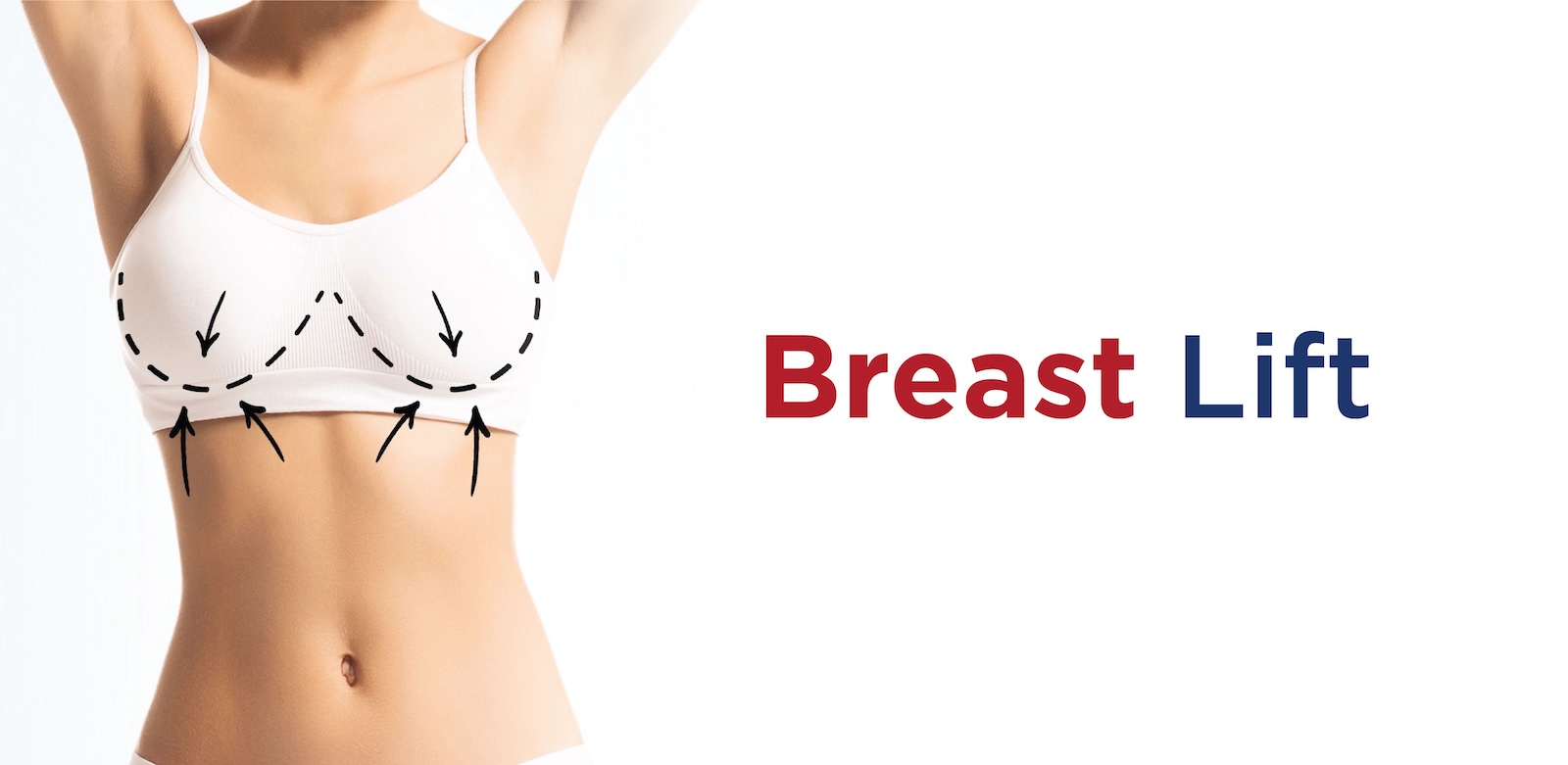Before undergoing a breast lift surgery, you should study information about the procedure, risks, results, gather information on any questions you have, speak with a doctor, and share your expectations with them for the best outcome and mutual understanding.
Techniques like Sizer, Photo Simulation, Laser Levelling, and Endoscope that aid in evaluation, surgical planning, and during surgery are currently available for breast surgery and help to achieve good surgical results.
Everybody’s natural breasts are different. Individual differences in breast shape can be attributed to a variety of factors, including age, heredity, weight loss, pregnancy, nursing, vigorous activities, and exercise without the use of supportive apparel. These factors alter the elasticity of the muscles and skin, which results in sagging, while genes and hormones have a major role in breast size.
Causes of breast shape changes
- Greater density of breast tissue results in firm, heavy breasts that are more prone to sagging than breasts with a mostly fat composition, which are softer and lighter.
- Original breast size: In long term, compared to women with medium- or small-sized breasts, women with relatively large breasts are more prone to experience sagging breasts.
- In addition to not wearing a bra that provides adequate support, exercises that involve a lot of swinging, high impact, and up-and-down movement can cause long-term alterations in the breast shape.
- Pregnancy, breastfeeding
- A significant change in weight in a short period of time, which may be caused by intentional weight loss or illnesses.
- Skin becomes less elastic with age, leading to sagging
- Breast weight is higher in those who are obese or overweight.
- Genetics
Breast Lift
Unbeautiful breasts in terms of size and shape or drooping breasts can negatively impact your everyday life, social interactions, personality, body confidence, and clothing choices. Breast lift surgery involves removing extra skin, contouring, realigning the nipples, and decreasing the size of the areola in order to restore the proper appearance of the drooping breasts. Several procedures are used in this surgery, including:
- Breast augmentation with internal lift
- Breast lift without implant
- Breast lift with implant
- Breast lift with fat grafting
An expert surgeon is able to provide advice, evaluate, and choose the best surgical technique, giving women the best outcomes and boosting their self-confidence.
Who is a good candidate for breast lift surgery?
- People who have sagging breasts due to aging, weight loss, childbirth
- People with low nipples
- Moms with sagging breasts due to breastfeeding
- Healthy, mentally sound individuals with reasonable expectations of outcomes
- Persons over 20 years of age (if under 20 years old, a letter of consent from a parent or legal guardian is required)
- People who are not pregnant or breastfeeding
- People without underlying diseases that are contraindications to surgery, such as hemophilia and Ehlers-Danlos syndrome
- If you want to lose weight, you should lose the desired weight before undergoing a breast lift
Possible risks associated with breast lift
While all surgeries carry risks, not everyone is at risk. Your doctor will provide you with a consultation and assessment of the risks, give you the opportunity to ask questions, and then decide on the surgical procedure together.
- In terms of scars, this surgery usually produces smooth appearance and the surgical scars are hidden in the appropriate location, if you have no prior history of keloid scars.
- The breast shape may not be as desired. The outcome depends on many factors. However, a skilled physician can offer guidance and select the kind of surgery that will produce the intended outcomes.
- Other possible risks include wound complications and nipple abnormalities, such as numbness or nipple necrosis. These complications are common in heavy smokers and those with underlying blood vessel issues, such as diabetes, hypertension, and high cholesterol. However, if the symptoms are well controlled, it is not a contraindication to surgery.
Pre-operative preparation for breast lift and breast reduction
6 months before surgery
- Isotretinoin, a vitamin A compound used to treat acne, should be avoided since it may slow the healing of wounds.
3 months before surgery
- Patients should take proper care of their bodies by exercising regularly and getting enough rest.
- Patients should to undergo an annual health check-up. If you have a chronic illness, you should consult a physician for treatment in order to manage your symptoms.
- If a patient has a history of breast cancer risk, they should get screened for breast cancer with a mammography.
4 weeks before surgery
- Stop smoking for at least four weeks prior to and following surgery.
- Avoid body piercing/tattooing or sunbathing. Take off any rings or piercings you may have in order to assess and treat any inflammation.
- Avoid surgery when you’re about to have your period. If you are not sure, consult your doctor to plan to postpone your period.
10 days before surgery
- Patients should stop taking any medications that may interfere with blood clotting, including:
- Blood thinners such as Aspirin, Coumadin, Ticlid, Plavix or Aggrenox (Pease consult your doctor about stopping the medication).
- NSAID pain relievers such as Ibuprofen, Advil, Motrin, Nuprin, Aleve, Relafen, Naprosyn, Diclofenac, Naproxen, Voltaren, Daypro, Feldene, Clinoril, Lodine, Indocin, Orudis, etc.
- Some sedatives and sleeping pills such as Zoloft, Lexapro, Prozac, Pristiq, etc.
- Avoid all types of vitamins and supplements that may affect blood clotting, such as Multivitamins, Fish oil, Omega-3, Co-enzyme Q10, Evening Primrose Oil, Glucosamine, Arnica, Ginseng, Gingko, herbs, etc.
In addition to the advice given above, you should study the details of breast lift surgery risks and outcomes, gather information on any questions you have, speak with a doctor, and share your expectations with them for the best outcome and mutual understanding.
Breast lift surgical procedures
- Your doctor will provide you with a consultation and give you the opportunity to ask questions before the surgery.
- The surgery takes about 3-6 hours.
- Anesthesia is given to the patient.
- After surgery, patients need to stay in the hospital for about 1-2 days.
- To monitor their progress and manage any potential side effects, patients must return for follow-up appointments on the 7 days, 10 days, 1 month, 3 or 6 months after the surgery.
Post-operative self-care
- You will be able to walk the day following surgery, however there may be some little discomfort or soreness around the surgical wound. The symptoms will eventually improve.
- The two breasts may appear different for one to three weeks due to bruising and oedema. After surgery, you must wait for the bruising and swelling to subside, which usually takes one to two months.
- This operation may lessen a sensation in the nipple area, but it will improve within 3-6 months.
- Usually, the surgical wound is swollen and slightly red for the first one to three months and then improve over the course of six to twelve months. Therefore, you should avoid direct sunlight for 3-6 months.
- You may experience nausea, vomiting, or a sore throat, depending on the individual, which are side effects of anesthesia.
- To lessen discomfort and infections, take your medication as prescribed by your doctor.
- See your doctor regularly for checkups and get advice from your doctor.
- To reduce scarring at the surgery site, stay out of the sun or wear sunscreen.
- During the first seven days, avoid lifting heavy objects and raising your arms over your head since this can lead to an inflammation of the surgical wound.
- Get enough rest. Avoid sleeping on your stomach as it can affect the shape of your breasts and the surgical wound. You may sleep with a few pillows to keep your head and upper body elevated to reduce swelling.
- After two weeks of resting at home, you can resume your job.
- You can take a shower the following day if the surgical site is covered with waterproof plaster, unless the doctor specifically orders otherwise.
- To stop the artificial breast from moving to the side or to the base of the breast, you should wear the hospital-provided bra or an underwire-free support bra for at least 6 to 8 weeks during the day and night.
- You should avoid exercising for 4 weeks. However, you can take short walks to reduce the chance of complications from abnormal blood clotting. After surgery, you can resume moderate exercise and resume vigorous exercise after two to three months.
- Avoid smoking and drinking alcohol for four weeks after surgery to prevent complications during recovery.
- Consume a balanced diet, avoid foods high in sodium since they can exacerbate swelling, get enough of fiber, and drink lots of water.
Breast reduction and breast lift help achieve balanced, attractive, natural-looking breasts, which boosts confidence in all women. These surgeries are common practices recognized throughout the world. Of course, there are some risks associated with the surgeries, but for ladies seeking confidence back, it is well worth the risk.



